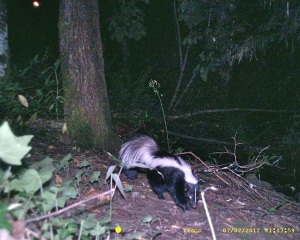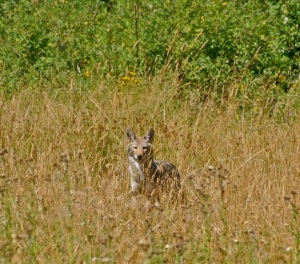I met Linda Jo Hunter at the home of friends Jurgen and Susan Hess. She wowed me with her tales of tracking bear, cougars, and other critters in the woods that surrounded us in the Columbia River Gorge. We got to know each other as Linda participated in, and later coordinated, the Plein Air Writing Exhibition. She is the author of Lonesome for Bears and has started a volunteer group to help landowners coexist with wild animals on their country property. She can be reached by email or on the Animal Arbitrators Facebook page.
Animal Arbitrators: Co-Existence Counseling
By Linda Jo Hunter
“Not under my porch!”
The lady was adamant that a skunk may not raise her young under the front porch of her house. She wanted the skunks killed, or maybe moved, but someone had to do something!
I watched the woman’s body language as she talked about her garden and house. She felt murderous and protective of all she felt was her own. While I listened, I noticed a small dish of leftover cat food by her left foot that had attracted several yellow jackets. As we talked the number of yellow jackets increased, each carrying away a little morsel of the leftovers and heading towards the woman’s garden.
I was trying to get to the bottom of why she hated skunks so much. There wasn’t a reason she could put her finger on, except that she objected to the smell of skunk and felt that if there were skunks under her porch that her whole house would be permeated with the smell of skunk spray. No, she didn’t have a dog. She had no cats either. But, she was feeding some in the neighborhood.
This is where my job starts. I pointed out that she was undoubtedly also feeding the mother skunk right there on her porch as well as several raccoons, whose tracks around the bowl were outlined in mud. My first suggestion was that she move the food, or at least take it indoors at night. Then we talked about skunks and I told her how they don’t want or intend to spray things but only do so when threatened. I described the body language that skunks use to warn that they are upset. They stomp their front paws and eventually, if you don’t get that message, they continue looking at you while their body makes a U-shape and the back end comes around to aim the spray.
When I mentioned that they eat yellow jacket nests she finally got interested. We found some chicken fencing in her shed and tacked it up to the edge of the porch to keep the animals out and she voluntarily moved her stray cat food bowl over in front of the shed. By the time I left, she hoped the mother skunk would move her family over to the shed and stay around.
When I visited her the next season, she was happily tolerating a family of skunks which she proudly pointed out had eliminated several pests in her yard, including yellow jackets. “Her” skunk had also sprayed a neighborhood dog, which left piles of unwanted poop in her garden. She was pleased as punch that the dog never came in her yard again.
Co-existing with wild animals is usually a matter of figuring out what exactly is going on in your personal habitat, rather than relying on what people have told you all your life. Any wild animal, no matter how cute or ugly has a place in the habitat or they wouldn’t exist or be there. Each time you make a change to your garden or grounds, you make changes in the habitat that affect these animals. Being aware of what eats what is one of the best ways not to make a mistake that will make you and all the animals uncomfortable.
For instance, if everyone in your neighborhood is insistent on killing coyotes because of something they “might” do, you could very likely have a problem with rabbits, mice, rats and ticks and other species too numerous to name. Ticks have an interesting reproduction cycle and must find a furry animal to hibernate on in order to multiply. The perfect candidates are in the squirrel family as well as other small mammals that coyotes control.
Oh, I can already hear the groans; “but they eat dogs and cats!” Yes, they do sometimes. However, so do owls, bobcats and other animals. Even domestic dogs kill pet kitties and cause mayhem that their wild buddies get blamed for. Some cats live for years around every kind of wild animal and have the wisdom to survive. Domestic dogs either have wild wisdom or they don’t. You know best about your pet; if it lacks the wisdom to survive in the face of wild animals it needs to be protected and supervised when outdoors.
Coexisting with wildlife can enrich your life. The bottom line is, that is why you moved to the country to begin with. The deer who grace your neighborhood in the evening come with their predators, which are just as necessary as the deer. Seeing a cougar, for instance, is not a life-threatening event, but rather a gift and a wonderfully wild experience. Cougars have a job to do and if they can freely move with their food they will do that job.
One of the best ways to enjoy your habitat is to be more aware of the animals that visit, pass through, or make it their territory and how you can assist that animal to fulfill its function. To that end, I teach people how to see animal passages and set up trail cameras so they can see what uses different parts of their land. Changing unwanted wild animal behavior can be as easy as moving an access site or moving a food source as long as you understand what it is. If a bear, for instance, has always visited a wild apple tree in your pasture, year after year, and suddenly that tree is fenced in, the bear will become a pest when it breaks down the fence. Instead, when the apples fall on the ground and the smell of apples gets strong, you can take a bushel basket and move the unwanted fruit over the fence, set up a trail camera and enjoy the results.
Fear of wild animals is something we all grew up with or, if we didn’t, various news media will make sure you pick up some fear, even if it isn’t rational or real. If you are afraid of a particular animal, say rattlesnakes, that is the animal you need to study. If you learn about their lives, and how they use and benefit your habitat you won’t have a reason to fear them because you won’t go stepping on one.
Bears seem to generate the most fear, although statistically they are the very least of our worries when it comes to being hurt by wildlife. Understanding the habits of your neighborhood bears is fascinating. First, they eat different things in each part of the season and if you find out what those things are in your area, it is a huge step in understanding the local natural history. Cubs learn what and when to eat by following their mothers closely for a year and a half. They lick their mother’s mouth when she eats something new to make sure they get the right things, and they remember even individual plants from one year to the next. Slowly, the news media is allowing us to know that bears are not meat-hungry predators that will eat a person if they find them out alone. Bears are mostly vegetarian and prefer their meat to be killed by some other animal—they like it aged. It seems like when they kill an animal to eat it, it is almost because of an unusual opportunity.
If you still don’t like the idea of a bear eating on your property, just remember that bears avoid skunks!

